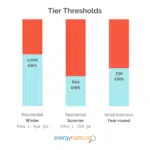
In Ontario, residential and small business customers billed under the Tiered pricing structure pay a set rate for the electricity they consume up to a kilowatt-hour (kWh) threshold per month. If the monthly threshold is exceeded, they are billed at a higher rate per kWh for all additional electricity consumed. In summary, by choosing this plan, you pay a fixed rate but have a usage limit.
Because there are usage changes and different habits between Winter and Summer, the tiers are different depending on the season. In the winter period (November 1 – April 30), the tier threshold for residential customers is 1,000 kWh, so that households can use more power at a lower price. In the summer period (May 1 – October 31), the Tier threshold for residential customers is 600 kWh. For small businesses is 750 kWh all year round.
Basically, the main benefit of the Tiered prices is that this option gives consumers the flexibility to use electricity at any time of day at the same price. However, we highlight again that the price will change once the threshold is exceeded during the month (and that is the downside for some.)
How tiered rates are determined
The Ontario Energy Board (OEB) determines the new Tiered rates at the same time as it sets the time-of-use (TOU) rates and the ULO rates. Considering the energy market, the OEB sets TOU (Time-Of-Use) and Tiered prices based on its forecast of the cost to supply households and small businesses over the next 12 months.
For residential customers, the threshold changes with the season to reflect changing usage patterns, since most people tend to use more energy to heat homes and to light up their houses during winter due to colder weather and shorter days (with less sunlight.)

Tiered pricing rates are set by the Ontario Energy Board. (Image: EnergyRates.ca/ Source: OEB)
Who is eligible?
Since November 1st of 2020, Regulated Price Plan (RPP) electricity customers can choose either time-of-use (TOU) pricing and Tiered pricing plans. RPP customers include:
If you live in a condominium or apartment that has its own individual meter and your bill comes from a company other than EPCOR, for example, you are a customer of a unit sub-meter provider (USMP). Therefore, you can’t switch to Tiered prices. This decision can only be made for the building as a whole by the “master consumer”, – the person that retained a USMP for the property.
In case you are a consumer buying electricity from an energy retailer, you will pay the electricity price set out in their contract. Once you have left their retail contract, you have a choice between paying TOU or Tiered prices. However, to understand the details of your energy contract, you need to contact your competitive energy retailer.
(May 1 – Oct 31) Summer 2025 Residential and Small Business Tiered Rates
Residential
- 9.3¢ per kWh for consumption up to 1,000 kWh/month (winter) and 600 kWh/month (summer)
11.0¢ per kWh for consumption above 1,000 kWh/month (winter) and 600 kWh/month (summer).
Small business (non-residential)
- 9.3¢ per kWh for consumption up to 750 kWh/month.
11.0¢ per kWh for consumption above 750 kWh/month.
The electricity bill you receive includes the costs for the electricity that you use (billed at Tiered rates), the services your local utility provides, and other costs of delivering electricity. In case of Other charges, they may also appear on your bill related to your account.
The benefits of the tiered pricing plan: How to know if it’s the right choice
As we said above, since there is a fixed rate with Tiered pricing, the consumer that chooses this option can use a certain amount of electricity each month at a lower, set price. Moreover, Tiered pricing allows the residents or business owners to use electricity regardless of the time (mornings, afternoons, evenings, or overnight), and can be more affordable compared to TOU (Time-of-Use) pricing IF the consumer doesn’t exceed a set amount of electricity.
To check if tiered electricity rates work for you, knowing how much electricity you consume is the first step. If your average usage for summer and winter are below the thresholds, then it would make sense to switch to Tiered. If you use devices/appliances all the time and often exceeds the set threshold for each season, then TOU could maybe be more cost-effective for your household. However, that will really depend on your consumption and habits.
To clarify, the Tiered plan is usually ideal if you live alone, if your family has low consumption, if you live in a smaller property and thus have lower electricity usage, or if you spend very little time at home, consequentially using less electricity.











